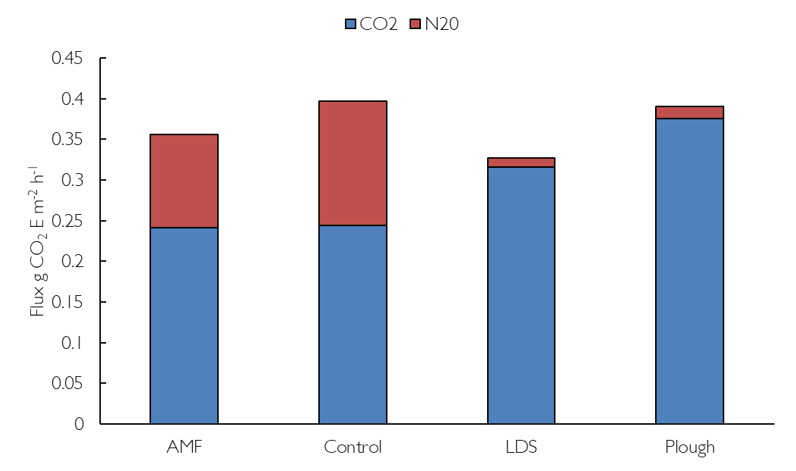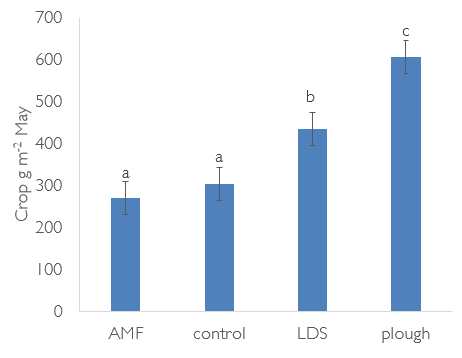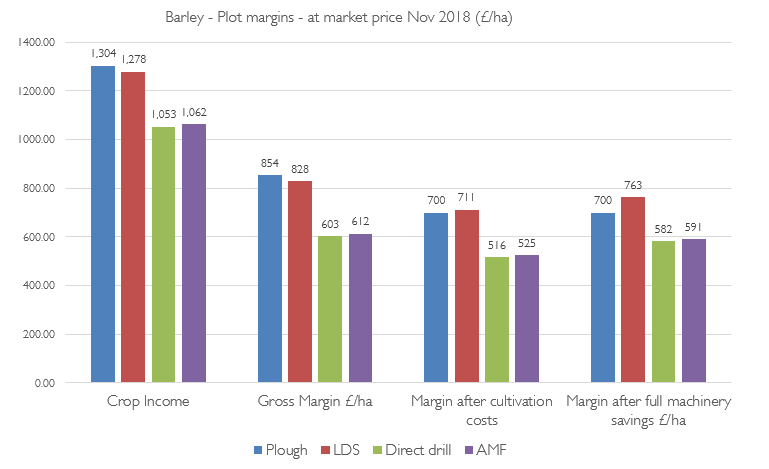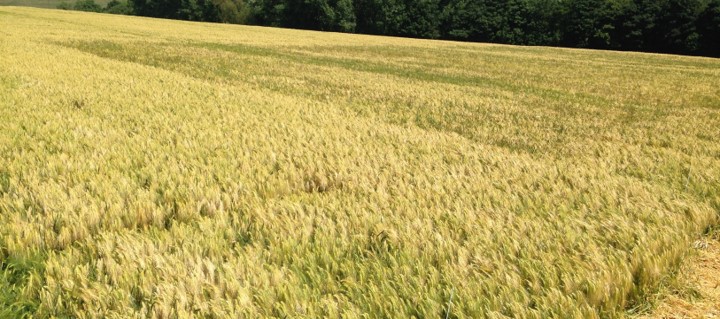Written by Joe Stanley from the Allerton Project
It’s well established, including by our own research (in part discussed in June’s article on our pioneering Conservation Agriculture trial), that a move to reduced tillage or direct drilling (DD) can generally be considered beneficial for the triumvirate of farm economics, soil health and environmental sustainability. With financial margins inexorable tightening, increasing recognition of the degradation visited on our farm’s most vital asset in recent decades, and increased public and political demands for natural capital recovery in the farmed landscape, reduced tillage and DD tick many boxes.

However, experiences abound of overly-rapid transitions to such systems which have met with initial setbacks, with farms simply shopping in existing equipment and making the transition from intensive tillage in a single season. Sometimes in combination with a poor planting season, this has often led to very poor establishment and soil conditions with a resultant sapping of enthusiasm – or even wholesale reversion to the previous system.
Here at the Allerton Project, we sit atop pretty consistent heavy Hanslope-Denchworth series silty clay loams. Although in some ways it’s been great to adopt a conservation agriculture system over the previous twenty or so years (with drastically improved workrates and reduced fuel usage from pounding clods into submission), such soils also provide their own specific challenges in a DD system, not the least of which is the risk of compaction.
Compaction is a form of soil degradation with detrimental effects on agricultural productivity through reduced crop growth, increased soil erosion and nutrient depletion. It can also lead to increased emissions of nitrous oxide (N₂O) as anaerobically active denitrifying bacteria in damp/wet compacted soils convert available nitrate from fertiliser into this highly warming greenhouse gas, with a carbon dioxide equivalent (CO₂e) of 298. Agriculture is responsible for some 75% of UK emissions of N₂O.
In 2018 we set out to investigate the potential impact of moving to a DD system as part of SoilCare, an EU-funded project which allowed farmers in our local area to prioritise research they considered particularly useful to them; compaction in a DD system was at the top of the list.

We set up a replicated experiment with three replicates per treatment in winter barley (2018) followed by winter beans (2019). The field was intentionally compacted by driving a tractor at right angles to the tramlines (can you imagine?!) We compared direct drilling directly into the compaction with a number of compaction alleviation methods; ploughing, a pass with a low-disturbance subsoiler (LDS) and application of a mycorrhizal (AMF) inoculant, which wasn’t expected to influence soil physical characteristics but could improve crop nutrient uptake through the fungal strands. All were established with a Dale EcoDrill.
In wet winter soils we recorded N₂O emissions 10 times higher in the compacted control than in the ploughed plots, and 15 times higher than in the LDS plots. During the summer, with dry soil conditions, comparative N₂O levels flattened out between the treatments. This therefore bore out the hypothesis that compacted soils can be at significant risk of becoming a major source of emissions in the move to a DD system, despite best intentions from a soil organic matter loss/carbon dioxide (CO₂) emissions point of view.
Indeed; we discovered that CO₂ losses from the two ‘disturbed’ treatments (subsoiled/ploughed) were significantly higher across the year than in the DD/AMF plots with microbes finding more available oxygen to help metabolise the soil organic matter, as would be expected. (Respiration was highest in the summer months – by around 130% – across all plots, but the significant differences in emissions were concentrated in the winter months immediately following cultivations). Indeed, CO₂ emissions from the plough plot were some 132% higher than from the control.

We also measured crop biomass and yield across the different treatments. In the winter barley crop in year one, biomass in the cultivated plots was significantly higher than in the DD and AMF plots (although this difference did not proceed to the bean crop in year two). Indeed, the plough biomass averaged some 600g/m² in May 2018, alongside around 400g/m² for the LDS versus around 300g/m² for both undisturbed plots. At harvest, this translated into a yield of 8.15t/ha in the ploughed plots versus 7.99t/ha for the LDS, 6.64t/ha for the AMF and 6.58t/ha for the DD. Although this seems substantial to me as a mere farmer, our research team assures me that the 1.5t/ha differential is not ‘statistically significant’, but is indicative of the difference between the treatments.
We also measured earthworm numbers and water infiltration across the field; as might be expected, earthworm numbers were significantly higher in the non-cultivated plots (and especially in the AMF plots in 2018) but water infiltration was again not ‘statistically significantly different’ across the piece – though it was higher in the cultivated areas.
As a whole, this research demonstrates that in soils liable to compaction particular care must be taken in the transition to a DD system. On emissions, when total CO₂ and N₂O outgassings were compared and adjusted for CO₂e, we discovered that the climate impact was least in the plots managed with an LDS, whilst emissions from the DD and ploughed plots were about even. However, if reduced fuel use was also taken into account in the DD plot (about 50% lower) then that would improve the picture for the non-cultivated control.

At the Allerton Project, this research has helped to inform the management of our soils. Although we direct drill as a policy, we also conduct regular monitoring of our soil health and structure and utilise our LDS where required to ameliorate compaction. This is especially important given that we do not operate a controlled-traffic system, and also operate a straw-for-muck deal in parts of the rotation which produces inevitable trafficking. Harvests such as that of 2023 also pose an issue for soil compaction, with increasingly variable and extreme weather patterns posing an increasing risk for soil travelability and health.
As part of other long-term trials on the farm, we have recorded the often-noted issues around soil structure in the transition from conventional tillage to reduced tillage and direct drilling; some of our VESS scores decline in quality in the early years, before the process of ‘self-structuring’ begins to take effect as organic matter levels and biology increase. It’s especially in this transitional period that care must be taken to avoid and alleviate compaction, through living roots if possible but mechanically if required. Indeed, we do utilise the plough within our normal rotation when agronomically justified; for us this is usually as a means of combatting blackgrass as part of a comprehensive integrated pest management strategy. Research as part of other long-term trials at Allerton has demonstrated that infrequent use of inversion tillage does not have the negative implications for soil health which might be feared.
The final piece of the jigsaw with regard to our compaction experiment was to run the financial numbers on the 2018 harvest. Although income/ha was highest on the ploughed ground, when adjusted for margin after cultivation and machinery costs (assuming lower kit requirements in a DD system) the LDS plots came out on top with a margin of £763/ha versus £700/ha for the ploughed, £591/ha for the AMF and £582/ha for the DD. What we must bear in mind with these results is that the DD control was heavily compacted; in optimum conditions we would expect (and can demonstrate from other research projects) that the DD would financially outperform the plough system; this data demonstrates the importance of mechanical compaction alleviation for profitability. It would seem that the AMF treatment had limited overall impact on most metrics measured, but again needs to be viewed in the context of challenging compacted conditions.
The value of much of the research we conduct at the Allerton Project is to convert many farms’ anecdotal experience into solid data via rigorous scientific analysis, and to then make that research easily accessible and digestible for farmers on the ground. Although it might come as little surprise to learn that compaction is bad for crop production, this piece of work attaches numbers to that assumption, as well as setting it in the wider context of soil emissions. It was also curious to note that the clear results in much of year one did not necessarily translate into year two, where there was no significant difference in yield between the various treatments in the following bean crop. Our understanding of soil science is still far from complete, and this work has filled one more small gap in our understanding on the road to sustainable


